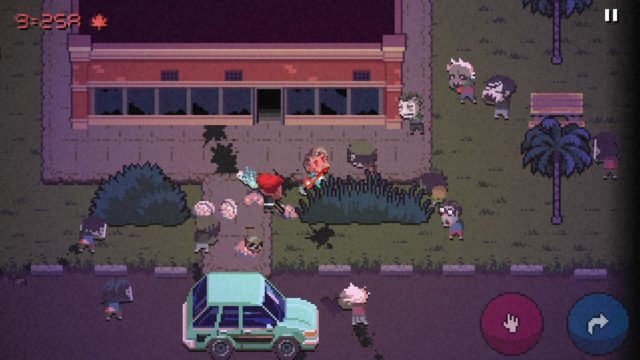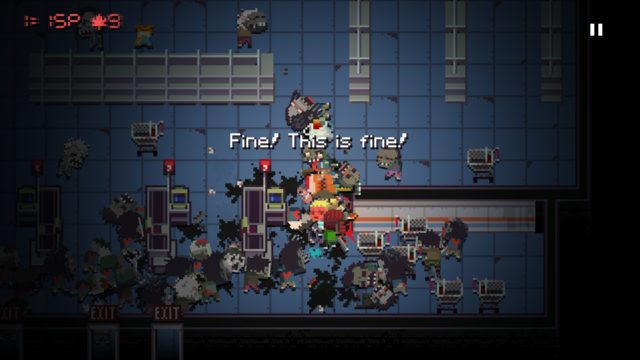Clever concept; fun, sometimes hilarious gameplay; high replay value
Understanding a lot of the gameplay comes through trial-and-error; better descriptions of equipment parameters would have been nice
Never let it be said that the 8-bit era didn’t leave its mark. Even as companies like Nintendo continue to re-release classics from the NES heyday, the pixelated wonders of the past continue to inspire brand-new games. Death Road to Canada is just such a game, channeling old-school values in a way that is smart, engaging, and ultimately successful.
Death Road to Canada, a multiplatform title, retails on Switch for $11.99. (It was originally scheduled to release on April 25, 2018, but was delayed out of respect for a horrific vehicle attack in Toronto, Ontario.) The graphics are vintage 8-bit, as is the music, although the sights feel a little more memorable than the sounds. The game bills itself as a “randomly generated road trip action RPG.” The title is more or less a roguelike game — in other words, each playthrough is randomly generated and death is permanent. As an action RPG, the combat is in real-time, with role playing elements throughout that allow characters to improve.
That all said, it doesn’t feel quite like the typical roguelike game. Where most games in this RPG subgenre are dungeon crawlers, this game is a survival adventure set in a zombie apocalypse, with the only hope for survival to escape to the friendly confines of Canada. Gameplay generally divides between text-based interactions on a road screen and in real-time combat across the various cities, buildings, and other locations players happen upon. Both parts of the game are fun (and at times downright hilarious) in their own way.

The game touts itself for its replay value, and it certainly delivers. Players begin each run with two characters (or one, if you feel like a bigger challenge), either randomly generated or custom created. It’s a bit of fun to create characters based on family and friends, but random characters— and sometimes animals— also make appearances. From there, it’s off to a run that is different each time the game is played. In general, the game does a pretty good job of not being too arbitrary, although sometimes fate can be cruel.
And death will happen. Often, especially early on. The zombie hordes are surprisingly persistent, and characters are not as powerful as you might hope, especially at the outset. Getting caught in a horde and eaten to death can be an early source of frustration. The silver lining is that death has some rewards; completing certain events in the game unlock zombie points that can be used to improve the stats of certain character classes and traits or unlock new ones, so even if you die, your labor can translate into better characters the next time around. The game also offers a few different modes, some of them harder or easier, to help create more variety.
The game offers a basic tutorial on combat and some descriptions of job classes and traits, but beyond that the game leaves a lot to trial-and-error. For example, characters come across a bevy of weapons along the trail, but the game offers very little guidance to the relative strength or endurance (weapons can break) of each individual weapon. Likewise, discovering which character classes work best takes a lot of experimentation, too, and it may be a while before players get a handle on what’s ideal. In some ways, though, this may be intentional, as it again encourages players to replay the game over and over.

Players start with two characters, but can build a party of four. This has its pros and cons: a larger party is more formidable in combat and has more skills for things like vehicle repair and medical care, but a larger party also consumes more food (a rare commodity) and can be susceptible to arguments if morale gets low. The game has a local co-op feature that allows a second player to join in, but the AI is generally competent and does a good job of keeping itself out of trouble. Rarely did this reviewer see the AI characters get themselves killed in circumstances that a normal player wouldn’t have, too.
Death Road to Canada is a quality game with a good deal of depth, both with the characters and the gameplay proper. The developers have made something that is both familiar and different, both weird and understandable. It takes a bit of time to grasp everything it has to offer, but it’s a game that is worth coming back to again and again. Gamers looking for a roguelike action RPG will especially enjoy this 8-bit survival tale.
Nintendojo was provided a copy of this game for review by a third party, though that does not affect our recommendation. For every review, Nintendojo uses a standard criteria.




 ShareThis
ShareThis





